
Alocasia is a genus of rhizomatous or tuberous, broad-leaved, perennial, flowering plants from the family Araceae. There are about 90 accepted species native to tropical and subtropical Asia and eastern Australia. Around the world, many growers widely cultivate a range of hybrids and cultivars as ornamentals.
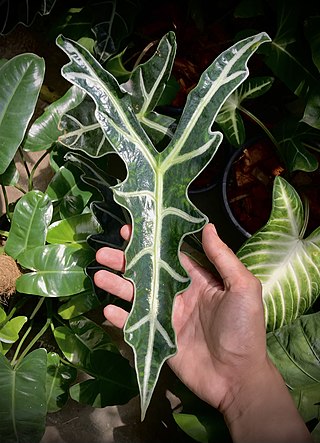
Alocasia sanderiana, commonly known as the kris plant or Sander's alocasia, is a plant in the family Araceae. It is endemic to Northern Mindanao in the Philippines, but is commonly grown as an ornamental plant worldwide. It is classified as critically endangered in the wild by the International Union for Conservation of Nature.
Amorphophallus preussii is a species of plant in the family Araceae. It is endemic to Cameroon. Its natural habitats are lowland tropical and subtropical moist broadleaf forests and subtropical and montane tropical and subtropical coniferous forests. It is a Vulnerable species threatened by habitat loss.
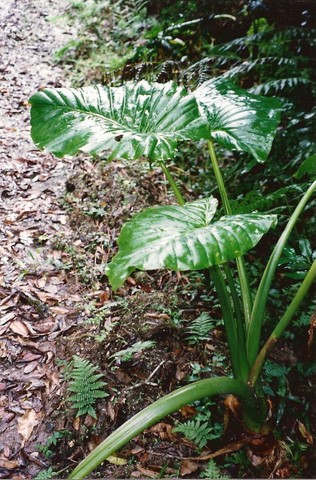
Alocasia brisbanensis, commonly known as cunjevoi or spoon lily, is a species of plant in the family Araceae native to rainforests of eastern Australia. The common name "cunjevoi" derives from the Bundjalung language of northern New South Wales.

Alocasia macrorrhizos is a species of flowering plant in the arum family (Araceae) that it is native to rainforests of Maritime Southeast Asia, New Guinea, and Queensland and has long been cultivated in South Asia, the Philippines, many Pacific islands, and elsewhere in the tropics. Common names include giant taro, giant alocasia, ʻape, biga, and pia. In Australia it is known as the cunjevoi.
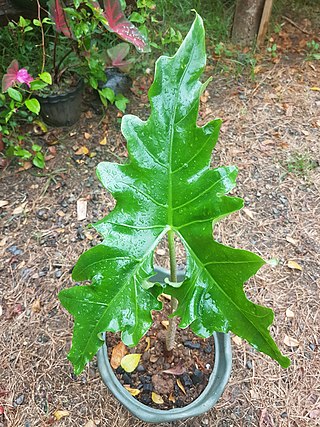
Alocasia nycteris, commonly known as the bat alocasia or the batwing alocasia, is a plant in the family Araceae. It is endemic to island of Panay in the Philippines. It is cultivated as an ornamental plant.
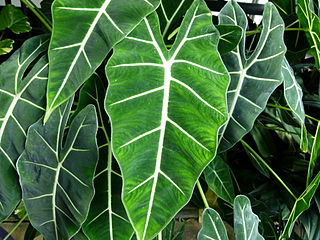
Alocasia micholitziana, commonly known as the green velvet taro or green velvet alocasia, is a plant in the family Araceae. It is endemic to the island of Luzon in the Philippines. It is commonly grown as an ornamental plant worldwide.
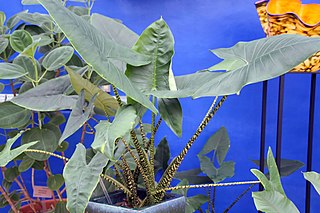
Alocasia zebrina, commonly known as the zebra plant or zebrina alocasia, is a plant in the family Araceae. It is endemic to the islands of Luzon, Mindanao, Leyte, Samar, Biliran, and Alabat in the Philippines. It is commonly grown as an ornamental plant worldwide. It is also locally known as gabing tigre in Tagalog. It is nationally listed as a threatened species and collection of A. zebrina from the wild is illegal in the Philippines.

Alocasia heterophylla is a plant in the family Araceae. It is endemic to the islands of Luzon, Mindanao, and Polillo in the Philippines.

Alocasia baginda is a species of flowering plant in the family Araceae, native to Kalimantan, Indonesia. As a houseplant it is rare in commerce, with the unimproved species, and the cultivars 'Dragonscale', 'Green Dragon' and 'Silver Dragon'.
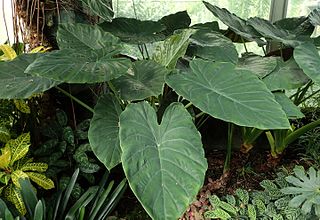
Alocasia wentii, the hardy elephant's ear, is a species of flowering plant in the family Araceae, native to the highlands of New Guinea. Occasionally kept as a houseplant, the unimproved species and some variegated cultivars are commercially available.
Alocasia reversa is a species of flowering plant in the family Araceae, native to Borneo. In its native habitat it is found on limestone outcrops, so as a houseplant it does not need heavy watering. It gets its specific epithet from the fact that its color pattern is reversed from the typical Alocasia, that is, its coloration is darker on and near the veins.
Alocasia gageana, the dwarf upright elephant ear or dwarf taro, is a species of flowering plant in the family Araceae, native to the Kachin Hills of Myanmar. Reaching 4 ft (1 m), it is only a dwarf when compared to the giant upright elephant ear Alocasia odora or to taro. It makes for a large houseplant, or an outdoor ornamental plant in tropical or (nearly) frost-free subtropical areas.
Alocasia melo is a species of flowering plant in the family Araceae, native to Sabah state in Malaysia. It grows on ultramafic soils. In the houseplant trade it is often sold as "Alocasia rugosa" due to its highly rugose leaves.
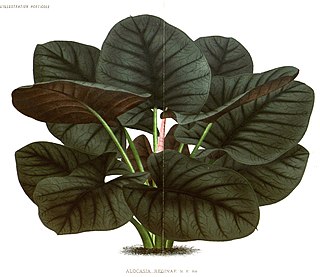
Alocasia reginae is a species of flowering plant in the family Araceae, native to Borneo. Occasionally kept as a houseplant, there are cultivars available, including 'Miri' and 'Elaine'.

Alocasia reginula, black velvet, is a species of flowering cormous aroid, native to Sabah state in Malaysia. This plant, often referred to as one of the "jewel" Alocasias, became increasingly popular among plant hobbyists between the years 2018 to 2020. Until as recently as 2021 though, not much was known about the plant or its origins. Originally described from cultivation, and often sold as “Alocasia 'Black Velvet'”, it is not a modern cultivar or hybrid; A. reginula is its own natural species. It is only known from dry, deeply shaded limestone cliffs in Tabin Wildlife Reserve. As a houseplant it needs sharp drainage or it will be very likely to rot.

Alocasia portei is a species of flowering plant in the family Araceae, native to Luzon in the Philippines. With Alocasia odora it is the pollen parent of the large landscaping plant Alocasia × portora.
Alocasia scalprum, the Samar lance, is a species of flowering plant in the family Araceae, native to Samar island, the Philippines. Well known from cultivation as a houseplant in the Philippines, and introduced to aroid enthusiasts as Alocasia cv. Samar Lance in 1984, it was not formally described as a species until 1999. Its glossy, lance-shaped leaves with embossed veins take on a blue sheen when mature. It is similar in appearance to Alocasia heterophylla.
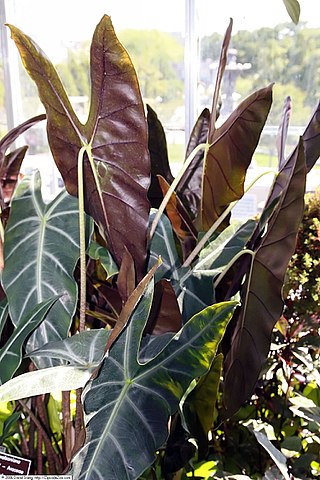
Alocasia longiloba is a species of flowering plant in the family Araceae. It is the namesake of a species complex. The complex has a widespread distribution; Guangdong, Hainan, and southern Yunnan in China, mainland Southeast Asia, and western and central Malesia.
Alocasia atropurpurea is a flowering plant in the family Araceae endemic to northern Luzon in the Philippines. It is classified as Critically Endangered by the IUCN Red List of Threatened Species and has only been recorded in Mount Polis and an unspecified locality in the Mountain Province.















